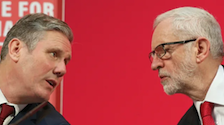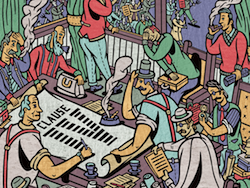TREVOR FISHER examines the causes and consequences of Labour’s often bitter splits into hard left and right factions. The soft left could provide the bridge, he says, but it remains organisationally weak and politically invisible.
In a perceptive article on Political Quarterly recently, Ben Jackson was right to argue that Labour’s deep split between its hard right and hard left factions is debilitating, although its impact is not always electorally damaging.
Nothing in the current era quite rivals 1931 when two impeccably right-wing figures, Prime Minister Ramsay MacDonald and Chancellor Philip Snowden, joined a Tory dominated national government and reduced Labour to 52 seats.
 Yet there is no doubt the splits recorded in the Forde report, revealing a virtual civil war in Labour’s Southside HQ, did not help the 2019 general election campaign, although it did not cause the defeat.
Yet there is no doubt the splits recorded in the Forde report, revealing a virtual civil war in Labour’s Southside HQ, did not help the 2019 general election campaign, although it did not cause the defeat.
Jackson is correct, too, to say Labour’s right sees office as the main objective of the party, while the hard left sees social and political change as the target. Yet, these two goals should not be mutually exclusive. If the hard left sees parliamentary government as the way forward, it should also recognise that winning elections is the mechanism to achieve that.
But before considering why the division between these wings is so sharp, it is important to note that, in truth, there are three tendencies in the party, not two, although only the hard right and hard left are well organised and visible.
Indeed, in the recent elections to Labour’s National Executive Committee (NEC), the constituency positions were filled by four right wing Labour To Win candidates, and four left wingers, plus “Open Labour’s Ann Black”, as Labour List described her. Black has won a place on the NEC since 2000, when she was vice chair of the now defunct Labour Reform Group. She does not need organised support to succeed.
But the soft left made little impact in other internal elections, so why are Labour’s politics so deeply binary?
Factionalism & Corbyn
The divide stems from the party’s historical clause 4, written in 1918, which seemed to commit the party to socialism. As Jackson rightly says, the right has never been interested in anything more than “ameliorative and deliverable reforms”, so the left accuse them of betraying the party’s highest goals.
 The right, in turn, accuses the left of acting in the interests of the Tories by putting forward impossible demands, although since Militant were expelled in the 1980s – in part for demanding the “nationalisation of the top 250 monopolies” – no section of the Labour left has called for extensive policy agendas.
The right, in turn, accuses the left of acting in the interests of the Tories by putting forward impossible demands, although since Militant were expelled in the 1980s – in part for demanding the “nationalisation of the top 250 monopolies” – no section of the Labour left has called for extensive policy agendas.
In 1995, Tony Blair, leading the New Labour faction of the Labour right, replaced the old clause 4 with a new one, although this made little difference to many on the left, who continue to inhabit a betrayal culture.
Although an impeccably hard left politician, Jeremy Corbyn made no attempt to revive the old clause 4 when he became leader, nor to introduce an extensive programme of nationalisation. Yet the right still saw him as an extremist, damaging the drive to replace the Tories, while the left believed he was campaigning for socialism. Yet Corbyn won the leadership in 2015 on soft left votes, not a socialist crusade.
It is often thought that Corbyn was elected on a wave of hard left activist support. There was no such wave. In fact, Corbyn’s nomination was secured partly by right wing Labour MPs such as Frank Field, Dave Lammy and Margaret Beckett, who wanted to ensure there was a debate. Beckett later admitted she had been a “moron” for so doing. Yet it was a plausible decision since very few members were hard left and, in the previous two leadership elections, John McDonnell and Diane Abbott had gained few of the members’ votes.
The right, however, did not understand the shifting motives of Labour’s soft left, which had been alienated by the concessions to Toryism, particularly on austerity, that had lost Labour its support in Scotland where 40 of 41 seats fell to the SNP. These members did not want any more concessions to the Tory agenda.
Far too little had been achieved by the Labour government of 1997 to 2010, and members wanted a change of direction. Power was no use if no progress was made, and Corbyn, despite his faults, said he would not accept any more shifts to the right. He won an unexpected victory based on soft left votes and, for a while, this improved Labour’s support.
As Neal Lawson, chair of the soft left Compass group, wrote in the Guardian on 8 June, “from his 2015 leadership victory to the following general election it [Corbynism] offered a screen on which people, tired of both technocratic and insipid New Labour wannabees, and austerity, projected their hopes and fears”. Hence Labour’s astonishing 40 per cent vote share in 2017.
But after 2017, Corbyn’s alliance fell apart, and the soft left had no organisational leverage. It is a recurring problem.
The moderate left
The 2015 revolt of the impeccably moderate soft left took a decade to emerge. Like the hard right, the soft left understands the value of being in office, and much was expected of Gordon Brown when Blair finally lost his appeal. Jackson valuably cites Brown arguing in 2005: “We have not recalibrated the debate as we should. We still have the right wing settling the terms of the debate…”
Indeed, it was clear that Blair had failed to set the political agenda, and Brown became the screen on which hopes and fears were projected. The soft left, which always backs a Labour government to keep the Tories out, backed Brown. And when he lost in 2010, it backed Ed Miliband over his brother David. Ed Miliband, alas, swung right, backing austerity.
The soft left is different from the hard left because it is not oppositionalist. It will back Keir Starmer while he looks like a winner. Like the party right, it is anxious to see a Labour government. But it does not see power as enough in itself and wants Labour’s politics to retain some element of principle.
The trajectory of Compass shows what happens when soft left politics is unable to gain traction inside the party. A soft left group initially very supportive of Brown, Compass became so disillusioned that it left Labour and now operates outside the party.
The other two tendencies are deeply oppositionalist – the hard left opposes the leadership unless it’s occupied by a hard leftist; while the right opposes those who insist Labour retains some element of principle in Labour poltics. Hoping these factions will agree to compromise is, alas, a bridge too far.
The best prospect is to develop an organised and structured soft left movement to balance out principle and pragmatism – the two poles of Labour’s factionalism. It is a project that has not yet developed but, given the dire effects of Labour splits, is now urgently necessary.
Much of Labour’s history since the 1918 constitution has been dominated by the party’s right, interspersed with short periods of left advance of which Corbynism was the most recent example. Currently, the right dominates the party leadership with its apparent revival of the New Labour approach of aiming low and achieving low.
The hard left is no answer to this, and never has been. But while the soft left remains largely invisible and disorganised, Labour’s internally destructive binary politics will continue to damage the party.
—-
Trevor Fisher was an honorary secretary of Labour Reform from 1995 to 2002 and a member of the Compass executive between 2007 and 2009.
He is editor of the Progressive Readers website.



4 October 2022
Here’s a dated item of mine, but it is still relates to Trevor’s approach.